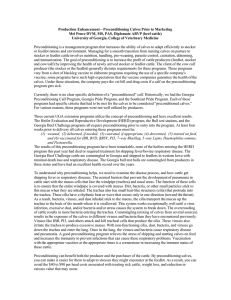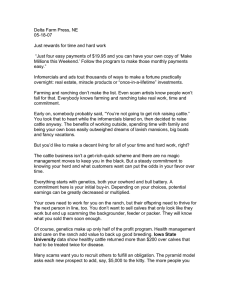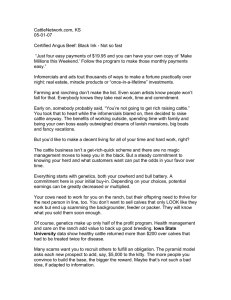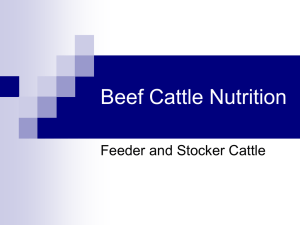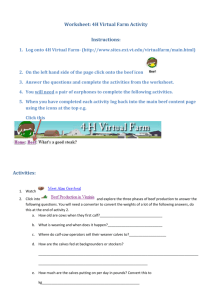Adding value to your calf crop through preconditioning prior to... By Mel Pence DVM MS PAS Diplomate ABVP (beef cattle)
advertisement
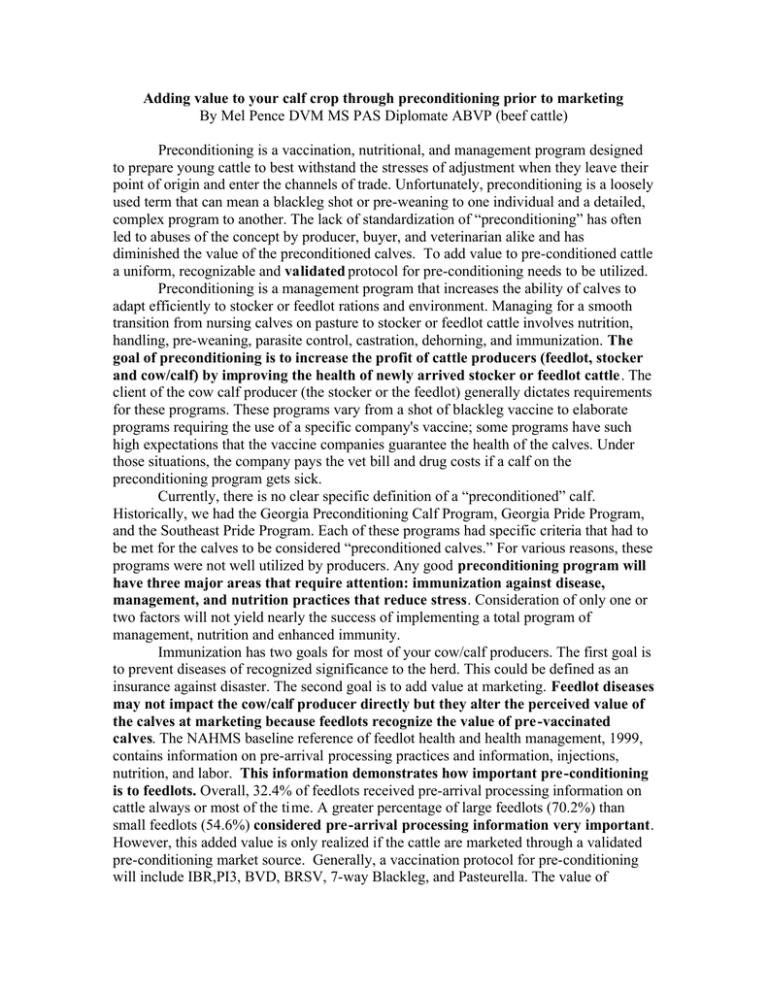
Adding value to your calf crop through preconditioning prior to marketing By Mel Pence DVM MS PAS Diplomate ABVP (beef cattle) Preconditioning is a vaccination, nutritional, and management program designed to prepare young cattle to best withstand the stresses of adjustment when they leave their point of origin and enter the channels of trade. Unfortunately, preconditioning is a loosely used term that can mean a blackleg shot or pre-weaning to one individual and a detailed, complex program to another. The lack of standardization of “preconditioning” has often led to abuses of the concept by producer, buyer, and veterinarian alike and has diminished the value of the preconditioned calves. To add value to pre-conditioned cattle a uniform, recognizable and validated protocol for pre-conditioning needs to be utilized. Preconditioning is a management program that increases the ability of calves to adapt efficiently to stocker or feedlot rations and environment. Managing for a smooth transition from nursing calves on pasture to stocker or feedlot cattle involves nutrition, handling, pre-weaning, parasite control, castration, dehorning, and immunization. The goal of preconditioning is to increase the profit of cattle producers (feedlot, stocker and cow/calf) by improving the health of newly arrived stocker or feedlot cattle. The client of the cow calf producer (the stocker or the feedlot) generally dictates requirements for these programs. These programs vary from a shot of blackleg vaccine to elaborate programs requiring the use of a specific company's vaccine; some programs have such high expectations that the vaccine companies guarantee the health of the calves. Under those situations, the company pays the vet bill and drug costs if a calf on the preconditioning program gets sick. Currently, there is no clear specific definition of a “preconditioned” calf. Historically, we had the Georgia Preconditioning Calf Program, Georgia Pride Program, and the Southeast Pride Program. Each of these programs had specific criteria that had to be met for the calves to be considered “preconditioned calves.” For various reasons, these programs were not well utilized by producers. Any good preconditioning program will have three major areas that require attention: immunization against disease, management, and nutrition practices that reduce stress. Consideration of only one or two factors will not yield nearly the success of implementing a total program of management, nutrition and enhanced immunity. Immunization has two goals for most of your cow/calf producers. The first goal is to prevent diseases of recognized significance to the herd. This could be defined as an insurance against disaster. The second goal is to add value at marketing. Feedlot diseases may not impact the cow/calf producer directly but they alter the perceived value of the calves at marketing because feedlots recognize the value of pre-vaccinated calves. The NAHMS baseline reference of feedlot health and health management, 1999, contains information on pre-arrival processing practices and information, injections, nutrition, and labor. This information demonstrates how important pre-conditioning is to feedlots. Overall, 32.4% of feedlots received pre-arrival processing information on cattle always or most of the time. A greater percentage of large feedlots (70.2%) than small feedlots (54.6%) considered pre-arrival processing information very important. However, this added value is only realized if the cattle are marketed through a validated pre-conditioning market source. Generally, a vaccination protocol for pre-conditioning will include IBR,PI3, BVD, BRSV, 7-way Blackleg, and Pasteurella. The value of modified live virus vaccine when compared to killed virus vaccine was investigated in a research report from Iowa State University. This review indicated that cattle vaccinated with a killed 4-way virus vaccine were 2.2 times more likely to be treated for bovine respiratory disease than cattle vaccinated with a modified live 4-way virus vaccine. Management practices to reduce stress are critical to the success of a preconditioning program. The best management system is to have a sound health program implemented before weaning. Calves should be castrated, dehorned and healed at least thirty days before shipment (castration and dehorn should ideally be done before the calf is a month old). Calves should be weaned forty five days before they are shipped to market. Preconditioned calves must be acquainted with feedbunks and water troughs to minimize the transition to feedlot environments. In addition, rations should be provided that are similar to those they will receive after marketing. Weaned calves started on feed adjust to movement and adapt to the feedlot with less shrink and susceptibility to disease. Nutrition plays a major role in resistance. The major feed constituents of proteins and carbohydrates are needed to build immunity in cattle. Micronutrients like cooper, selenium, zinc, and vitamin E are necessary to produce a good immune response. Provide fresh, clean water, preferably in a trough so the calves will be acquainted with this type of water source. Feed calves in a bunk to minimize feed contamination and adaptation to bunk feeding. External and internal parasite control should be implemented. The immune response to vaccination may be decreased by poor nutrition (including heavy parasite loads), heat stress, improper vaccine or syringe handling and/or concurrent immunosuppressive disease like BVD. Heat stress is a major factor in resistance. Cattle vaccinated during extremely hot weather will not respond to vaccinations as well. Heat stress causes the release of cortisol in cattle that suppresses the ability of the immune system to respond to disease. Certain infections will result in a decrease in the resistance of cattle. Bovine Virus Diarrhea (BVD) is “immuno-suppressive” and makes cattle more likely to get other infections. We can enhance the natural resistance of our cattle through management procedures that minimize stress and crowding, proper nutrition and biosecurity. Three current UGA extension programs utilize the concept of preconditioning and have excellent results. The Heifer Evaluation and Reproductive Development (HERD) program, the Bull test stations, and the Georgia Beef Challenge programs all require preconditioning prior to entry into the program. At least four weeks prior to delivery all calves entering these programs must be: (1)weaned, (2) dehorned, if needed, (3) castrated, if appropriate, (4) de-wormed, (5) started on feed, and (6) vaccinated for IBR, BVD, BRSV, PI3, 7-way Blackleg, , Haemophilus somnus, Pasteurella and 5-way Lepto. The results of these preconditioning programs have been remarkable. The Georgia Beef Challenge cattle are commingled in Georgia and shipped to feedlots in western Iowa with minimal death loss and respiratory disease. The Georgia bull test bulls are commingled from producers in three states and have had an excellent health record over the years. To understand why preconditioning helps, we need to examine the disease process, and how cattle get shipping fever or respiratory diseases. The normal barriers that prevent the development of pneumonia in cattle start with the mucus cells that line the windpipe (trachea) and nasal areas. The function of these cells is to ensure that the entire windpipe is covered with mucus. Dirt, bacteria, or other small particles stick to this mucus when they are inhaled. The trachea also has small hair-like structures (cilia) that protrude into the trachea. These cilia have a rhythmic beat or wave that occurs only in one direction (toward the throat). As a result, bacteria, viruses, and dust inhaled stick to the mucus, the cilia transport the mucus up the trachea to the back of the mouth where it is swallowed. This system works exceptionally well until a virus infection, excessive dust, and/or bacteria and/or stress causes the system to break down. The overcrowding of cattle results in more bacteria entering the trachea. Commingling (mixing of calves from several sources) results in the exposure of the calves to different viruses and bacteria than they have encountered previously. Viruses like IBR, PI3, and others attack and kill tracheal cells that produce the cilia. These viruses also irritate the trachea to produce excessive mucus. With non-functioning cilia, dust, bacteria, and viruses go down the trachea and enter the lung. Once in the lung, the viruses and bacteria cause respiratory disease and pneumonia. A good preconditioning program relieves the stress of shipping and starting calves on feed and increases the immunity to prevent infections that can cause these respiratory problems. Vaccination with the appropriate vaccines at the appropriate times is a cornerstone in increasing the immune status of these cattle. Disease in cattle involves the epidemiological triad of pathogen-host-environment. If any of these factors are out of balance, disease can occur. We influence this balance by the protocols for preconditioning we implement. By enhancing host immunity through nutrition and vaccination we decrease disease. If the environmental pathogen load (number of bacteria or virus in the calves environment) is too high it can overcome host immunity. Pathogen overload can occur when cattle are placed in confined areas and/or exposed to cattle that are shedding enormous quantities of respiratory virus. When the host is exposed to pathogens that are unfamiliar and an immune response to that pathogen has not occurred, disease can occur. This is the situation when cattle are commingled with other producer's cattle during marketing. The stress of movement, relocation to unfamiliar locations with strange cattle, adaptation to unfamiliar feeds and water all result in stress and the release of cortisone. Cortisone reduces the ability of white blood cells to respond to bacteria and viruses (pathogens). This is a cumulative process and the more stress placed on a calf, the higher the cortisone level. The goal of preconditioning is to spread out the necessary events that result in stress during a calves life. We influence this cumulative stress by vaccination before weaning, revaccination at weaning, weaning 45 days or more before shipping, dehorning and castrating early in life, handling cattle to reduce stress, and adaptation to feedlot type rations and conditions before shipping.
